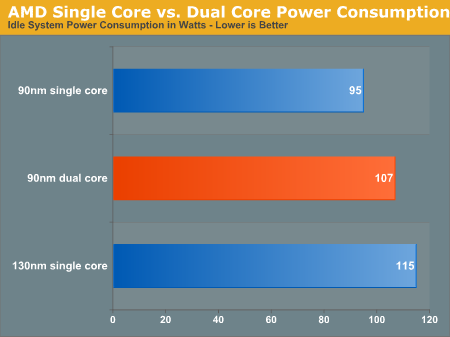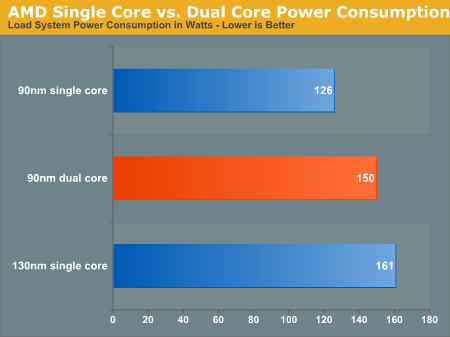AMD's Athlon 64 X2 4800+ & 4200+ Dual Core Performance Preview
by Anand Lal Shimpi on May 9, 2005 12:02 AM EST- Posted in
- CPUs
Power Consumption: Athlon 64 vs. Athlon 64 X2
In Part II of our preview of Intel's dual core processors, we noted that the addition of a second CPU core generally didn't increase overall system power consumption by that much. In fact, the Pentium D 2.8GHz vs. single core 2.8GHz comparison yielded only a 15% increase in system power consumption under load for the dual core CPU. While we didn't look at power consumption in our dual core Opteron review, armed with desktop parts, we were ready to look at how desktop power consumption was affected by the move to dual core.Single core AMD CPUs have always consumed less power than single core Intel chips; in fact, the 130nm Athlon 64 FX-55 consumes less power than a 3.0GHz Pentium 4 (5xx or 6xx series).
How much more power would a dual core Athlon 64 X2 consume? To answer this question, we looked at three CPUs on the same platform and measured system power consumption. We used a 130nm Athlon 64, a 90nm Athlon 64 and a 90nm dual core Athlon 64 X2 - all clocked at the same frequency and with the same per-core cache sizes. The results are below:


If you're worried about the Athlon 64 X2 generating too much heat, there's no reason to be concerned - if you're happy with the heat levels of your current 130nm Athlon 64, the X2 will run even cooler.










109 Comments
View All Comments
FlakPanzer - Monday, June 20, 2005 - link
This looks very promising, my next rig is definately going to have one of these fine AMD X2 processors.cryptonomicon - Wednesday, June 1, 2005 - link
anand, thanks for the preliminary overclocking results. me and my DFI compadres are very eager to see how this chip overclocks and hope you add an overclocking page section as soon as you receive a production X2.gamara - Thursday, May 12, 2005 - link
Would be interesting to also see if DC had any affect on SLI performance. Not sure if the driver work of splitting the duties for 2 video cards would be streamlined with a second core on the processor.coldpower27 - Wednesday, May 11, 2005 - link
#88 are you talking about the PD 3.0GHZ 356US or the PD 2.8GHZ 241US? The 3.2GHZ 530US is the worst price/performance DC in Intel's arsenal it cost more then twice as much as a single core and then some.Just like how the 4600+ and 4800+ are now costing more then twice the single core versions.
I don't understand why people are going to assume the motherboard is expensive. Why must you have the flagship 955X motherboard?
The lanuch pricing of the 955X is 50US, which is the same as the price of the 925X when it was launched.
There is also the 945P chipset to consider which also supports Dual Core and is a less expensive alternative price at 38US which is only 1 dollar more then what the i915P chipset cost at launch.
Since the chipsets base pricing match what the 925X and 915P were at launch we should logically assume that pricing of these chipsets will be similar to what i915 and i925 were at launch.
phaxmohdem - Wednesday, May 11, 2005 - link
Oh yeah baby 100th post... how often do you get that honor? even if you have to cehat to get it *cough* post 99phaxmohdem - Wednesday, May 11, 2005 - link
lalala ala al ala ala alaphilthedrill - Wednesday, May 11, 2005 - link
#97, are you being serious? Read my post on #81.Performance drops with HT when there are memory bandwidth intensive apps due to the shared data TLB. The shared FSB also hurts Intel, and it only gets worse as you scale up with more processors.
AtaStrumf - Wednesday, May 11, 2005 - link
Since the advent of HT on P4, AMD has been at a great disadvantage in multitasking scenarios and I thought dualcore would end that. Well, I guess P4 is just better at that. Really ironic, when AMD has touted K8 as being designed from ground up for DC and Intel just slapping two cores together - LOL.Nontheless AMD is still doing great with X2 chips, and I too can't wait to get one, since I think we all multitask non-stop, even if we don't realize it (AV, Antispyware, SETI, FAH, Word, IE, Firefox, Opera, Acrobat, ACDsee, Photoshop, Outlook, BT, eMule, ... and the we open a game on top of that). Just yesterday my A64 3200+ S754 / 1 GB RAM gave me real trouble with gazlion windows open, while writing my graduation paper. Had to restart the bastard, grrr.
Son of a N00b - Tuesday, May 10, 2005 - link
TY for including OC results...maybe a whole 'nother article on this?
Quanticles - Tuesday, May 10, 2005 - link
i think if ppl want AMD's prices to come down, then we should all pitch in and build a new fab for them